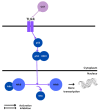The Role of Catestatin in Preeclampsia
- PMID: 38473713
- PMCID: PMC10931722
- DOI: 10.3390/ijms25052461
The Role of Catestatin in Preeclampsia
Abstract
Preeclampsia (PE) is a unique pregnancy disorder affecting women across the world. It is characterized by the new onset of hypertension with coexisting end-organ damage. Although the disease has been known for centuries, its exact pathophysiology and, most importantly, its prevention remain elusive. The basis of its associated molecular changes has been attributed to the placenta and the hormones regulating its function. One such hormone is chromogranin A (CgA). In the placenta, CgA is cleaved to form a variety of biologically active peptides, including catestatin (CST), known inter alia for its vasodilatory effects. Recent studies indicate that the CST protein level is diminished both in patients with hypertension and those with PE. Therefore, the aim of the present paper is to review the most recent and most relevant in vitro, in vivo, and clinical studies to provide an overview of the proposed impact of CST on the molecular processes of PE and to consider the possibilities for future experiments in this area.
Keywords: catestatin; chromogranin A; preeclampsia; pregnancy.
Conflict of interest statement
The authors declare no conflict of interest.
Figures




Similar articles
-
Chromogranin A demonstrates higher expression in preeclamptic placentas than in normal pregnancy.BMC Pregnancy Childbirth. 2021 Oct 7;21(1):680. doi: 10.1186/s12884-021-04139-z. BMC Pregnancy Childbirth. 2021. PMID: 34620125 Free PMC article.
-
Reduction in CgA-Derived CST Protein Level in HTR-8/SVneo and BeWo Trophoblastic Cell Lines Caused by the Preeclamptic Environment.Int J Mol Sci. 2023 Apr 12;24(8):7124. doi: 10.3390/ijms24087124. Int J Mol Sci. 2023. PMID: 37108287 Free PMC article.
-
Proteolytic cleavage of human chromogranin a containing naturally occurring catestatin variants: differential processing at catestatin region by plasmin.Endocrinology. 2008 Feb;149(2):749-57. doi: 10.1210/en.2007-0838. Epub 2007 Nov 8. Endocrinology. 2008. PMID: 17991725 Free PMC article.
-
Catestatin: A Master Regulator of Cardiovascular Functions.Curr Med Chem. 2018;25(11):1352-1374. doi: 10.2174/0929867324666170425100416. Curr Med Chem. 2018. PMID: 28443506 Review.
-
Cardioprotection against ischemia/reperfusion injury and chromogranin A-derived peptides.Curr Med Chem. 2012;19(24):4074-85. doi: 10.2174/092986712802429966. Curr Med Chem. 2012. PMID: 22834798 Review.
References
-
- Garovic V.D., Dechend R., Easterling T., Karumanchi S.A., Baird S.M., Magee L.A., Rana S., Vermunt J.V., August P. Hypertension in Pregnancy: Diagnosis, Blood Pressure Goals, and Pharmacotherapy: A Scientific Statement from the American Heart Foundation Chair] on behalf of the American Heart Association Council on Hypertension, Council on the Kidney in Cardiovascular Disease Science Subcommittee, Council on Arteriosclerosis, Thrombosis and Vascular Biology, Council on Lifestyle and Cardiometabolic Health, Council on Peripheral Vascular Disease, and Stroke Council. Hypertension. 2021;79:E21–E41. doi: 10.1161/hyp.0000000000000208. - DOI - PMC - PubMed
-
- Bartal M.F., Sibai B.M. Protoc High-Risk Pregnancies an Evidence-Based Approach Seventh Ed. John Wiley & Sons, Ltd.; Hoboken, NJ, USA: 2023. Preeclampsia; pp. 517–528. - DOI
-
- ACOG . Obstetrics & Gynecology. Volume 133. ACOG; San Francisco, CA, USA: 2019. p. 1. - DOI
-
- Brown M.A., Magee L.A., Kenny L.C., Karumanchi S.A., McCarthy F.P., Saito S., Hall D.R., Warren C.E., Adoyi G., Ishaku S. The hypertensive disorders of pregnancy: ISSHP classification, diagnosis & management recommendations for international practice. Pregnancy Hypertens. 2018;13:291–310. doi: 10.1016/j.preghy.2018.05.004. - DOI - PubMed
Publication types
MeSH terms
Substances
Grants and funding
LinkOut - more resources
Full Text Sources
Medical
Research Materials

